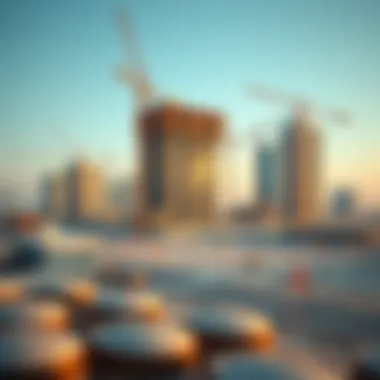Exploring Palm Jebel Ali: Completion, Impact, and Future


Intro
The Palm Jebel Ali, a monumental undertaking in Dubai, is not just another real estate project; it represents an ambitious vision of luxury and opulence. Nestled in the sparkling waters of the Arabian Gulf, the development aims to redefine coastal living with its unique architecture and potential for growth. Early enthusiasm surrounding the project suggested it would usher in a new era for Dubai's property market. However, as with many grand designs, the road has been riddled with challenges, causing delays and transforming expectations along the way.
Understanding the nuances of the Palm Jebel Ali project is crucial, especially for investors, homebuyers, and real estate professionals who are keen on navigating the evolving landscape. This article will dissect various dimensions of the development, including timelines, market insights, and investment strategies. By examining the intricate tapestry of this project, stakeholders can grasp significant implications for the future of Dubai’s real estate sector.
Overview of Palm Jebel Ali
Palm Jebel Ali stands as a notable landmark in the ambitious landscape of Dubai's real estate ventures. This grand project, initially slated for completion in the early 2000s, was conceived as an extension of the renowned Palm Islands. However, its significance transcends mere geography—it's about the bold vision that reflects Dubai’s relentless pursuit of luxury and innovation in urban development.
Historical Context
The inception of Palm Jebel Ali can be traced to the early 2000s when the developer Nakheel introduced the idea as part of a broader strategy to diversify Dubai's economy, primarily relying on tourism and real estate. This ambitious project aimed to attract affluent buyers and investors, showcasing the emirate's mastery in land reclamation and advanced engineering techniques. Unlike its predecessor, Palm Jumeirah, Palm Jebel Ali was designed to feature a symphony of residential, commercial, and leisure facilities, all perched on a sprawling man-made archipelago.
However, as with many large-scale developments, various challenges emerged, leading to delays. Economic fluctuations, global crises, and shifting market demands impacted the project’s trajectory. Initially pegged for completion in 2008, Palm Jebel Ali's timeline was adjusted amid the 2008 financial crisis, which had widespread repercussions across Dubai's property market.
In recent years, there has been renewed interest in the project as Dubai's real estate sector rebounds. Investors are now keeping a keen eye on Palm Jebel Ali, speculating its return to the limelight as a coveted destination for luxury living.
Architectural Vision
The architectural vision for Palm Jebel Ali encapsulates both grandeur and sustainability. The island was envisioned to feature stunning waterfront properties enveloped by lush greenery and vibrant community spaces. Central to its design are unique residential clusters, each offering distinctive living experiences, which reflects a thoughtful approach to urban planning.
Not only does this design emphasize aesthetic appeal, but it also incorporates futuristic aspects, such as smart technology and eco-friendly materials. The potential for integrated green spaces within the community aims at fostering a thriving environment aligned with contemporary sustainability practices. Such innovation not only caters to the preferences of modern buyers but also responds to Dubai's commitment to creating a balanced relationship between nature and urban development.
The juxtaposition of luxury and functionality shapes the architectural narrative of Palm Jebel Ali, positing it as a blueprint for future developments in the region. With its visionary design, Palm Jebel Ali is poised to capture the imaginations of investors, homebuyers, and expats alike, standing as a testament to Dubai's ambition to redefine the essence of urban living.
Completion Date Insights
In any significant real estate development, the dates associated with key milestones hold a paramount importance. In the case of Palm Jebel Ali, comprehending the completion dates can unveil insights into the overall trajectory of the project's progress and its impact on Dubai's property market. Knowing when major phases are expected to finish not only aids investors and buyers in planning their moves, but it also shapes market expectations and community sentiment. A construction timeline acts almost like a blueprint, providing stakeholders with a framework for understanding the temporal dimensions of such a grand undertaking.
Original Timelines
When Palm Jebel Ali was initially conceived, ambitious timelines were set to match the soaring aspirations of Dubai. The project kicked off in 2002, with original timelines estimating a completion by 2010. This aggressive schedule aimed to align with Dubai's broader vision of establishing itself as a global hub for tourism, business, and luxury living. The idea was to create not just another piece of real estate, but an entire living ecosystem that would attract affluent expatriates, tourists, and businesses.
However, like many monumental projects around the globe, these early projections were overly optimistic given the complexities of construction and logistics unique to such large-scale developments.
Current Projections
Fast forward to today, the revised timelines reflect a more cautious approach. Current estimates suggest that while more work is being undertaken, a full completion could stretch into 2025 or beyond. The gradual shift in these timelines indicates an adaptation to the challenges encountered, combining lessons learned with the ongoing ambition to bring Palm Jebel Ali to fruition. Moreover, these extended timelines provide a strategic opportunity for potential buyers to reassess the market landscape, allowing for better-informed decisions aligned with their investment goals.
Factors Influencing Delays
The road to completion for Palm Jebel Ali has not been devoid of roadblocks. Several factors have played a crucial role in extending completion timelines, including but not limited to:
- Economic Fluctuations: The global financial landscape, notably after the 2008 crisis, led to adjustments in funding and investment strategies.
- Regulatory Pressures: Navigating the intricate local governance and regulations requires time and effort, as stakeholders must ensure compliance with all standards set by UAE authorities.
- Construction Complexities: Given the island's unique layout and the environmental factors at play, achieving the architectural vision presents unforeseen challenges that can drive up timelines significantly.
In summary, while the completion date for Palm Jebel Ali has evolved over the years, understanding these insights equips investors, buyers, and other stakeholders with the foresight needed to navigate this dynamic market. Furthermore, this understanding serves to align expectations with reality, making for a more strategic investment environment.
Economic Impact of Palm Jebel Ali
The Palm Jebel Ali development is not just a remarkable feat of engineering and design; its economic ramifications ripple across Dubai's real estate sector and beyond. With strategic location in the Arabian Gulf and distinct architectural vision, the project attracts investors, boosts property values, and elevates Dubai’s status as a global hub for tourism, commerce, and luxury living.
Investment Opportunities
Investors are keeping a keen eye on the upcoming Palm Jebel Ali project for several reasons. The potential for significant returns is a major draw. As affluent buyers seek unique and premium properties, the demand for residential units in such iconic developments often leads to substantial price appreciation over time.


- Luxury housing: When completed, Palm Jebel Ali will feature high-end villas and apartments that cater to both local and expatriate populations. The upswing in demand for these properties is expected, particularly because Dubai's population continues to grow.
- Tourism prospects: The development of leisure facilities such as resorts, marinas, and entertainment venues is anticipated to attract tourists from around the globe. Hence investors can benefit from hospitality ventures.
- Commercial real estate: Opportunities abound for developing retail spaces and business centers that will complement the residential offerings. The increase in foot traffic will likely enhance the profitability of commercial ventures.
In the long run, the Palm Jebel Ali project stands as a beacon for foreign direct investment (FDI) in the UAE. The Emirate's government aims to position Dubai as a top destination for expatriates and business ommunity alike.
Market Trends Analysis
Assessing current market trends in Dubai's real estate sector provides insights into the significance of the Palm Jebel Ali project. With its unique selling propositions, the development may help offset current market challenges.
- Sustained property interest: Even amid global economic fluctuations, Dubai's real estate retains its allure. Investments from Asian and European investors demonstrate consistent trust in the market.
- High rental yields: Despite fluctuating prices, areas close to iconic developments generally see more stability and higher rental yields. As such, properties in Palm Jebel Ali are anticipated to maintain robust rental rates.
- S sustainable living: Increasingly, buyers are looking for developments that prioritize eco-friendliness and sustainability. Palm Jebel Ali’s planned use of green building standards and innovations may resonate well with buyers.
Through the lens of economic impact, Palm Jebel Ali represents both immediate financial prospects and long-term growth potential, contributing to a more robust and diversified real estate market in Dubai.
"The success of Palm Jebel Ali will not only shape its surrounding area, but it will also influence Dubai's economic landscape as a whole."
For additional insights, you can explore relevant resources on real estate developments at Wikipedia or Britannica.
The economic prospects are intertwined with strategic decision-making and insight into buyer preferences, making the Palm Jebel Ali project a critical case study for stakeholders across Dubai's real estate landscape.
Real Estate Dynamics in Dubai
Dubai's real estate market is an ever-shifting landscape, where trends can rise and fall faster than a sand dune in a desert storm. The Palm Jebel Ali development is a significant part of this matrix, reflecting not just architectural ambition but also shifting buyer preferences, investor appetites, and overall market dynamics. Understanding these elements is vital for anyone looking to engage with Dubai’s property scene, be it through investments, purchases, or sales.
Buyer Demographics
When it comes to the buyers in Dubai, the demographics are as diverse as the cultures cohabiting in the city. Traditionally, expatriates have made up a substantial portion of the property market, drawn to the region’s tax benefits and quality of life. Middle-class families, particularly from South Asia, form a significant part of the buyer pool, often seeking affordable yet high-quality homes.
The younger generation, particularly Millennials and Gen Z, also brings new dynamics into the arena. These groups tend to prioritize eco-friendly living spaces and technology-infused homes. The lifestyle appeal of developments like Palm Jebel Ali, with its promise of luxurious living alongside sustainability efforts, attracts this demographic, which seeks not just homes but a lifestyle.
- Key buyer demographics include:
- Expatriates from various countries
- Young professionals
- Families looking for long-term investments
- High-net-worth individuals for luxury investments
Given the rapid growth in tourism and business opportunities in Dubai, attracting a mix of local and international buyers remains a critical focus for developers. Failing to pin down these demographics could leave investors like deer in headlights, unsure where to direct their efforts.
Investors’ Considerations
For investors, Palm Jebel Ali represents a particularly appealing prospect, but it doesn't come without its share of complexities. Location remains a high priority. Proximity to the city center, recreational facilities, and potential for property appreciation are always in the forefront of an investor's mind. Furthermore, anticipated developments in transportation infrastructure, like the new metro lines planned for Dubai, could greatly enhance the area's allure.
Investors are keenly aware of factors influencing market performance, including:
- Regulatory frameworks: Understanding local laws regarding property ownership, especially for expatriates, can make or break an investment decision. The UAE has relatively relaxed laws compared to other countries, but being informed is crucial.
- Market trends: Keeping a keen eye on price fluctuations and new listings in similar developments can provide insight into the demand dynamics of the area.
- Economic factors: Global economic health can affect investor confidence in Dubai’s market. Events like the COVID-19 pandemic can lead to abrupt market downturns or spikes.
Rewards can be substantial. Investing in a developing area like Palm Jebel Ali may yield higher returns off the back of its impending completion, but it requires a thorough understanding of risk factors. The importance of a well-thought-out strategy that includes an exit plan cannot be overstated.
"In Dubai, timing can be everything. Understanding the pulse of the real estate cycle is paramount for informed investing.”
Potential investors should approach the Palm Jebel Ali development armed with knowledge and a clear vision of their goals. Balancing interest rates, market conditions, and personal financial circumstances can vastly alter the landscape for savvy real estate enthusiasts.
Sustainability and Innovation
The Palm Jebel Ali development stands not just as a symbol of opulence in Dubai, but also as a beacon for sustainable and innovative design principles. Emphasizing sustainability in such colossal projects isn’t just good practice—it’s vital. The integration of eco-friendly solutions and advanced technologies can drastically reduce environmental impacts while enhancing the quality of life for those who inhabit and visit these spaces.
Environmental Considerations
When it comes to Palm Jebel Ali, the environmental considerations are paramount. With climate change looming large, integrating sustainability into urban planning is crucial. This development aims to balance luxury with ecological stewardship.
Factors such as energy consumption, waste management, and biodiversity are at the forefront. For instance, employing renewable energy sources, like solar power, significantly cuts down on carbon emissions. Additionally, incorporating green spaces and native plant species can help preserve local flora and fauna, maintaining ecological integrity.


Furthermore, water management strategies are essential. Given the arid climate of Dubai, water conservation measures must be implemented. Advanced irrigation systems, waste-water recycling, and desalination technologies could bolster sustainability efforts.
"Sustainability isn’t about doing less harm. It’s about doing more good."
Technological Advancements
Innovation is another pillar of the sustainability framework for Palm Jebel Ali. The project's use of cutting-edge technology not only enhances efficiency but also elevates the living standards within the area.
Smart city technologies can transform urban life. From energy-efficient smart meters to intelligent traffic management systems, these technological advancements can drastically improve a resident's quality of life. Implementing IoT (Internet of Things) devices will allow residents to monitor their home energy usage in real-time, optimizing consumption and cutting costs.
Moreover, automated waste collection using sensor-equipped bins is a practical application that can keep the environment clean while minimizing labor costs. The idea is simple: by deploying drones or automated vehicles for inspections and maintenance, the upkeep of the community can happen seamlessly without hindering the aesthetics of the project.
In summary, the confluence of sustainability and technology in the Palm Jebel Ali Development serves as a model for future urban projects, showing that it is entirely feasible to blend luxury living with responsible environmental practices. This commitment to innovation not only positions Palm Jebel Ali as a premier destination in Dubai but also sets a standard for developments globally.
Relevant Resources
Community Development Aspects
The Palm Jebel Ali project goes beyond luxury real estate; it's about creating a thriving community. This initiative has potential far-reaching implications for residents and investors alike. When you think of community development, you envision a blend of lifestyle, amenities, and infrastructure that seamlessly elevates the quality of life.
Lifestyle and Amenities
Life at Palm Jebel Ali isn't just about convenience—it's about enrichment. The developers have envisioned a community where families flourish and interactions thrive.
With various residential options, ranging from villas to luxury apartments, the lifestyle is designed to cater to diverse demographics. Add to that premium amenities like
- Sprawling parks with playgrounds for kids,
- Community centers that serve as hubs for gatherings,
- Retail outlets that offer shopping experiences, and
- World-class dining spots where culinary enthusiasts can explore.
Imagine waking up to serene beach views and the city skyline in the backdrop. Evening strolls on tree-lined promenades could become a norm, fostering community bonds and encouraging a healthy lifestyle.
This emphasis on lifestyle amenities will not only attract expats and families but also contribute significantly to the region's economic vibrancy. The idea is to create a melting pot where memories are built, and connections are made.
Infrastructure Growth
Infrastructure plays a pivotal role in shaping any community, and Palm Jebel Ali is no exception. The development will incorporate modern roads, reliable public transport systems, and advanced utilities that ensure residents enjoy an uninterrupted lifestyle.
An array of key infrastructure elements includes:
- Transport Connectivity: With ease of access to Dubai's main highways and public transport, commuting will be a breeze for residents and visitors. This connectivity fosters not only local travel but also regional integration.
- Healthcare Facilities: Well-planned healthcare centers within the community will ensure quick access to medical services, boosting the sense of security among residents.
- Educational Institutions: High-quality schools and educational facilities are crucial. They will set the stage for future generations and create an educated populace ready to take on challenges.
- Public Spaces and Recreation: The inclusion of community parks and sports facilities will provide ample opportunities for leisure and recreation, promoting a well-rounded lifestyle that values both work and play.
"The success of a community cannot solely be measured in buildings but in the lives that are lived within them."
In summary, the community development aspects of Palm Jebel Ali are not just about bricks and mortar. They embody a lifestyle that combines luxury with accessibility, sustainability with innovation, painting a picture of a vibrant future. As investors or potential homeowners delve deeper into the various offerings, recognizing the significance of these elements can steer informed decisions in their journey within Dubai's evolving property landscape.
Palm Jebel Ali vs. Palm Island
When diving into the real estate landscape of Dubai, the Palm Jebel Ali and Palm Island present two monumental developments that have caught the eye of investors and developers alike. To understand the significance of Palm Jebel Ali in this context, one must navigate through the unique attributes and implications these two landmarks hold for the property market.
Comparative Analysis
The Palm Island, widely known as Palm Jumeirah, has already established itself as a premier destination for luxury living and tourism. It showcases a successful blend of opulent resorts, lavish residences, and bustling shopping venues. However, its counterpart, Palm Jebel Ali, aims to offer an additional layer of opportunities that could reshape perceptions of luxurious living in Dubai.
In comparing both projects:


- Size and Scope: Palm Jumeirah is smaller and more developed, while Palm Jebel Ali is set to be larger, potentially accommodating more residents and amenities.
- Investment Potential: Investors currently flock to Palm Jumeirah, yet the emerging market in Palm Jebel Ali presents untapped potential, appealing to those hunting for the next big opportunity.
- Community Vibe: Palm Jebel Ali is planned around a holistic community experience with sustainability at its core, whereas Palm Jumeirah is more focused on individual luxury.
This comparison hints at the dynamic shifts in the competitive landscape of Dubai's property market, where both developments offer distinct advantages.
Unique Selling Points
What sets Palm Jebel Ali apart from Palm Island are its unique selling points that cater to both residents and investors. First, the development's commitment to sustainability positions it as a forward-thinking choice for environmentally-conscious buyers. The integration of parks, green spaces, and eco-friendly technologies may attract a demographic eager to live in harmony with nature.
Moreover, Palm Jebel Ali's slightly more affordable housing options could tap into a broader market, including expatriates and first-time buyers. Here are a few specific selling points:
- Innovative Infrastructure: With plans for extensive waterfront properties and public spaces, it could foster a vibrant community culture.
- Future Growth: As a newer project, there are still opportunities for significant appreciation in property values compared to the already saturated Palm Jumeirah market.
- Diverse Amenities: The envisioned facilities aim to include cultural hubs and recreational areas, making it appealing for families and young professionals alike.
"The allure of Palm Jebel Ali lies not just in its grandeur but in its promise to reimagine luxury living along sustainable lines."
The evolving narrative surrounding these two developments underscores the importance of understanding not just the markets themselves, but also the lifestyle changes they represent for Dubai's future.
Legal Framework and Regulations
In the world of real estate, especially in a standout market like Dubai, understanding the legal framework is crucial for anyone looking to venture into the property landscape. The Palm Jebel Ali project is no exception. A clear grasp of ownership laws and regulatory challenges enhances not just investor confidence but also paves the way for a structured and seamless experience in this intricate system. This section aims to dissect these components for those keenly interested in the intricacies of this monumental undertaking.
Ownership Laws
The ownership laws governing Palm Jebel Ali present an essential part of its allure. In Dubai, foreign investors, including expatriates, can own property in designated areas, making investments vastly appealing. However, the laws concerning ownership come with specific stipulations that need careful consideration:
- Freehold vs. Leasehold: Investors often face the choice between freehold and leasehold properties. Freehold means you own the land and the property outright. Leasehold, conversely, grants ownership for a set number of years—usually 99—making it vital for potential buyers to understand the implications of each.
- Registration Process: A transparent registration process enhances security for buyers. Papers must be filed with the Land Department to solidify ownership, which includes a one-time registration fee of about 4% of the purchase price.
- Residency Visa Implications: Owning property can also lead to residency benefits. Those purchasing property valued above a certain amount—typically AED 1,000,000—may qualify for a long-term residency visa, which is crucial for expatriates looking to settle.
These elements create a legal environment where potential buyers can feel grounded and secure in their investments.
Regulatory Challenges
While the landscape may seem inviting, regulatory challenges can throw a wrench in the works. Investors and developers involved in Palm Jebel Ali should be aware of the following:
- Zoning Regulations: Zoning laws dictate how land can be used. In Palm Jebel Ali, certain parcels may be earmarked for residential, commercial, or mixed-use developments. Understanding these can prevent costly missteps in planning and development.
- Building Codes: Compliance with local building codes is non-negotiable in Dubai. These codes ensure safety, environmental integrity, and aesthetic coherence within developments. Failure to adhere can lead to substantial fines or project delays, impacting overall profitability.
- Changing Regulations: The regulatory environment can change, driven by policy shifts aimed at stimulating the economy or protecting the environment. Staying informed about these changes is vital for long-term strategy, particularly in a rapidly evolving market.
"Navigating through legal intricacies is not for the faint-hearted; it demands diligence and clarity."
Investors and stakeholders need to acknowledge the ever-changing nature of regulations, as this knowledge can significantly influence project success and sustainability in the long run. Staying abreast of ownership laws and regulatory challenges gives a clearer view of what is necessary to thrive in the Palm Jebel Ali project, allowing for more calculated investment decisions.
Future Developments and Prospects
The overarching importance of focusing on future developments and prospects for Palm Jebel Ali cannot be overstated. With a project of this scale and ambition, understanding its anticipated growth is essential for investors, buyers, and other stakeholders. As the landscape of Dubai's real estate market continues to evolve, Palm Jebel Ali promises to be a key player, shaping investment strategies and community planning. By examining projected growth, potential risks, and rewards, we can paint a clearer picture of what lies ahead. This is not just about new homes or developments—it's about the broader implications for the region's economic vitality and architectural evolution.
Projected Growth
Projected growth for Palm Jebel Ali is an area rich with possibilities. Initial studies suggest an increase in both population and tourism, thanks to unique features designed to draw in both local and foreign interest. The real estate sector is particularly keen on how this development can serve as a magnet for high-end investors looking to diversify their portfolios. This includes residents who embrace luxury living, drawn by sprawling residential areas and captivating recreational activities on offer.
While it’s difficult to pin down exact numbers, some forecasts indicate that with the planned amenities and luxurious facilities, property values could see a substantial climb over the next decade. Factors contributing to this growth include:
- Infrastructure Development: Improved access roads and public transport initiatives are expected to make commuting smooth, thus attracting professional residents.
- Tourism Integration: The design aims to harmonize with Dubai's existing attractions, enhancing its role in the tourism ecosystem.
- Community Engagement: The emphasis on creating community spaces fosters a sense of belonging that can draw families and long-term residents.
Potential Risks and Rewards
As with any substantial undertaking, investing in Palm Jebel Ali comes with its share of risks and rewards. Understanding these can help potential stakeholders navigate their options with a clearer head.
On the positive side, the rewards may include:
- High Returns on Investment: If property values rise as projected, early investors could benefit significantly when they choose to sell.
- Enhanced Urban Experience: Living in a well-planned environment can lead to improved quality of life, making it attractive not just for individual residents but also for businesses.
- Sustainable Development: Innovations in construction and planning could lead to a more sustainable living environment, appealing to environmentally conscious investors.
However, risks can arise from:
- Market Fluctuations: Economic factors beyond one's control, such as global financial shifts or economic slowdowns, can have adverse effects on property demand.
- Infrastructural Delays: Any hiccup in construction schedules can affect timelines and ultimately, property values.
- Regulatory Shifts: Changes in real estate laws could pose challenges for ownership and investment strategies.
In summary, the trajectory for Palm Jebel Ali is promising, yet it's essential for investors and residents alike to stay informed about the various dynamics at play. The balance of risks and rewards underscores the importance of due diligence. Enriching this community could pave the way for a prosperous future and redefine urban living in Dubai.







